Kutsinta (cuchinta) are Filipino steamed cakes made with flour, tapioca flour, and brown sugar. Soft, chewy, and topped with grated coconut, they're a delicious breakfast, snack, or dessert.
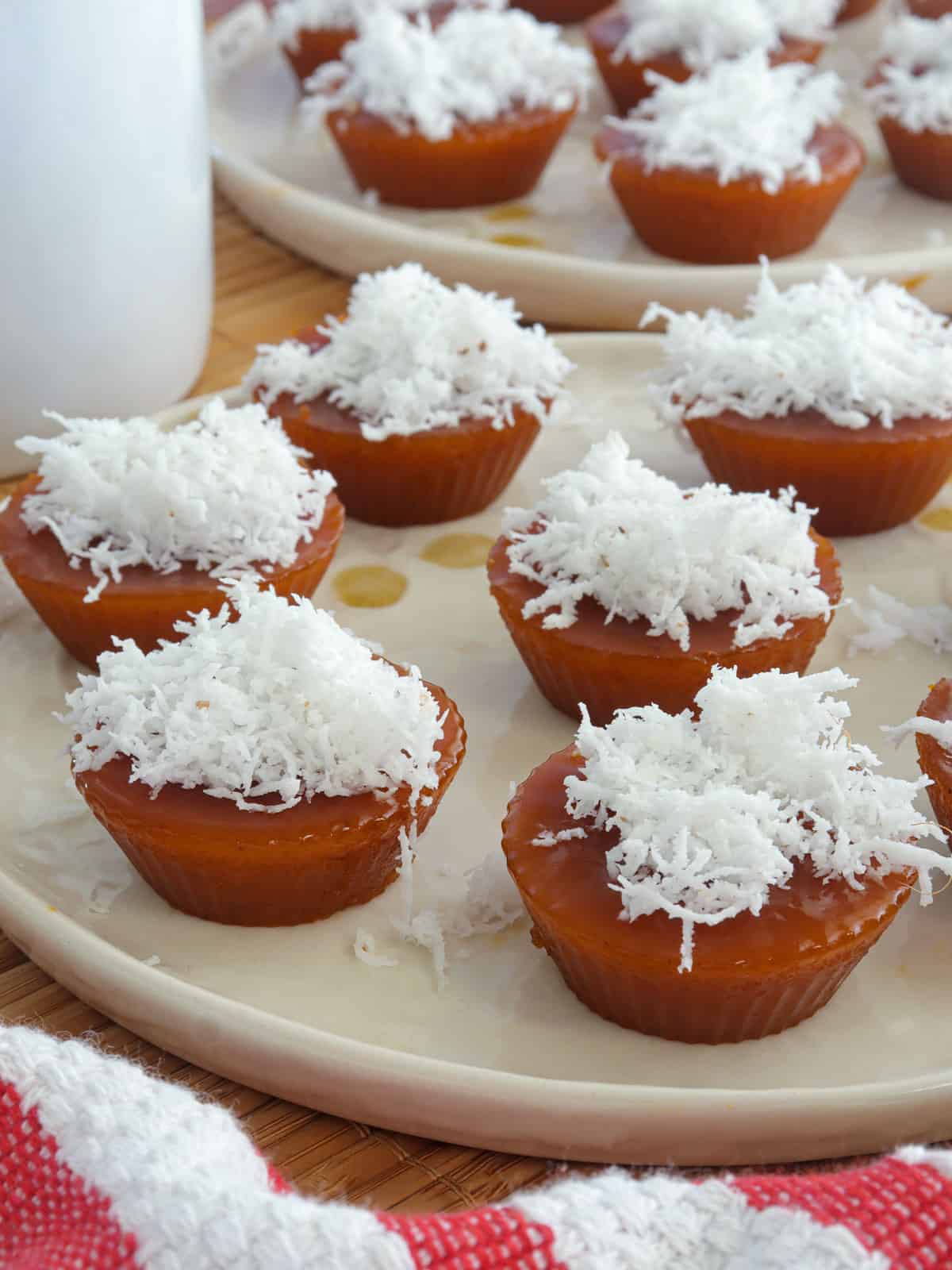
I've been looking for a good recipe for kutsinta or cuchinta since forever, but my search and kitchen experiments have been sorely disappointing. That was until last weekend, when my kumare posted on Facebook a picture of the kutsinta she made and how she finally nailed the recipe after two years of trial and error.
I was so excited reading her post that I PM'ed her as fast as my stubby fingers could type! I am unsure of the time difference between California and Vancouver, where she lives, but I was glad she replied with the recipe and had me on my kutsinta-making project in thirty minutes flat. Thank heavens for awesome friends 🙂
I made a couple of bites of the steamed cakes following her method, and I had to agree; she indeed nailed it! While most of the recipes I've encountered in the past use rice flour, her version uses all-purpose flour and tapioca flour, which, along with the addition of lye water, produces the soft and chewy texture I like.
Are you in the mood for more puto recipes? Try this easy Puto with tons of cheese and this Puto Lanson made of grated cassava. Enjoy!
Ingredient notes
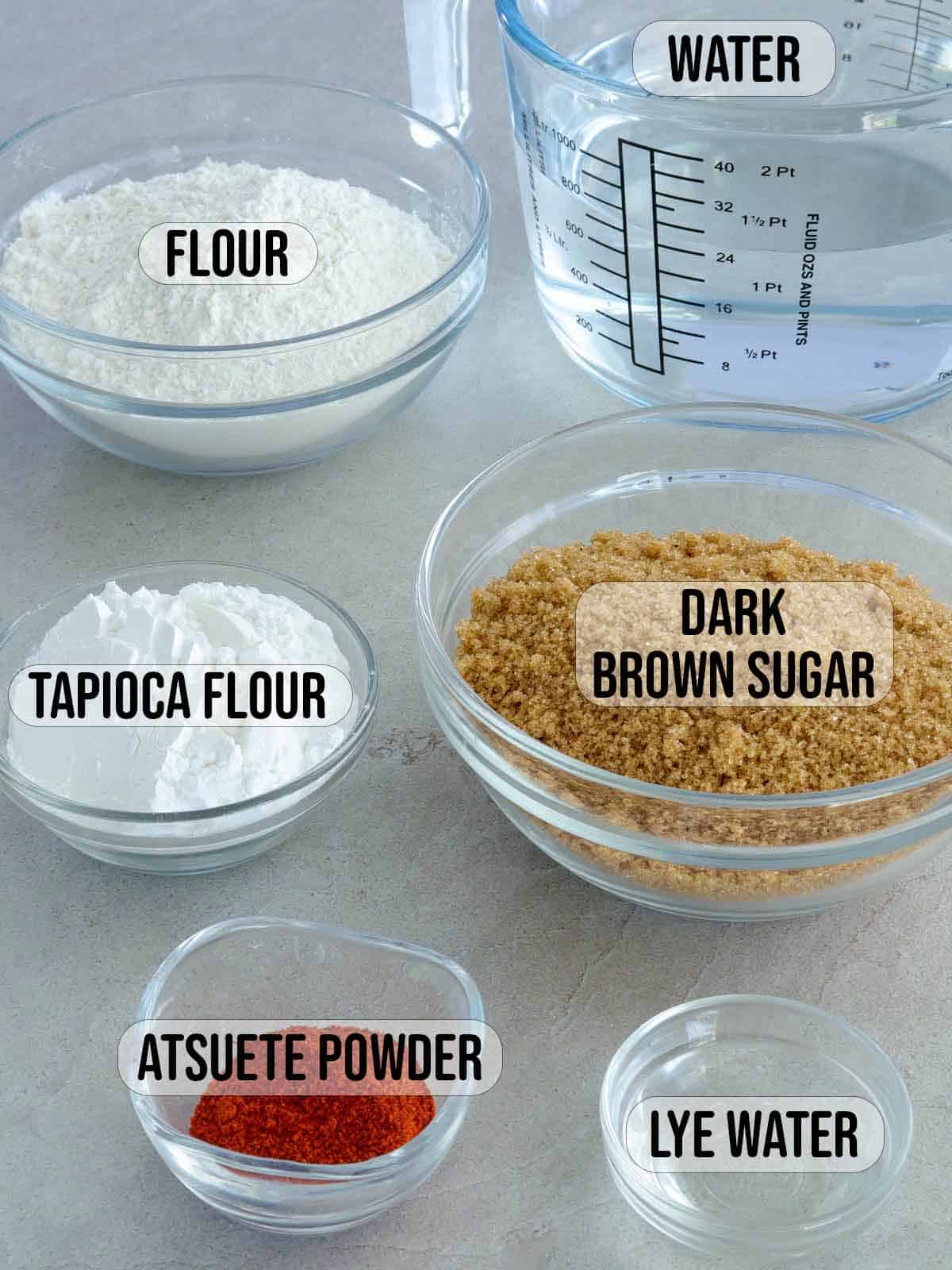
- Flour- the recipe uses a mixture of all-purpose and tapioca flour for a soft and chewy texture.
- Brown sugar- adds color and sweetness
- Water- the ratio of flour and liquid in the recipe yields the texture I like. Less water will result in a tougher cuchinta, and more water will create a softer consistency.
- Atsuete/annatto powder- enhances color. You can use more or less depending on the depth of color desired and the brown sugar used. Note that the color will deepen as the mixture cooks.
- Food-grade Lye water- locally known as lihiya. It softens the texture for a chewy texture and boosts color. Add sparingly as it can impart a bitter taste.
Kutsinta cooking process
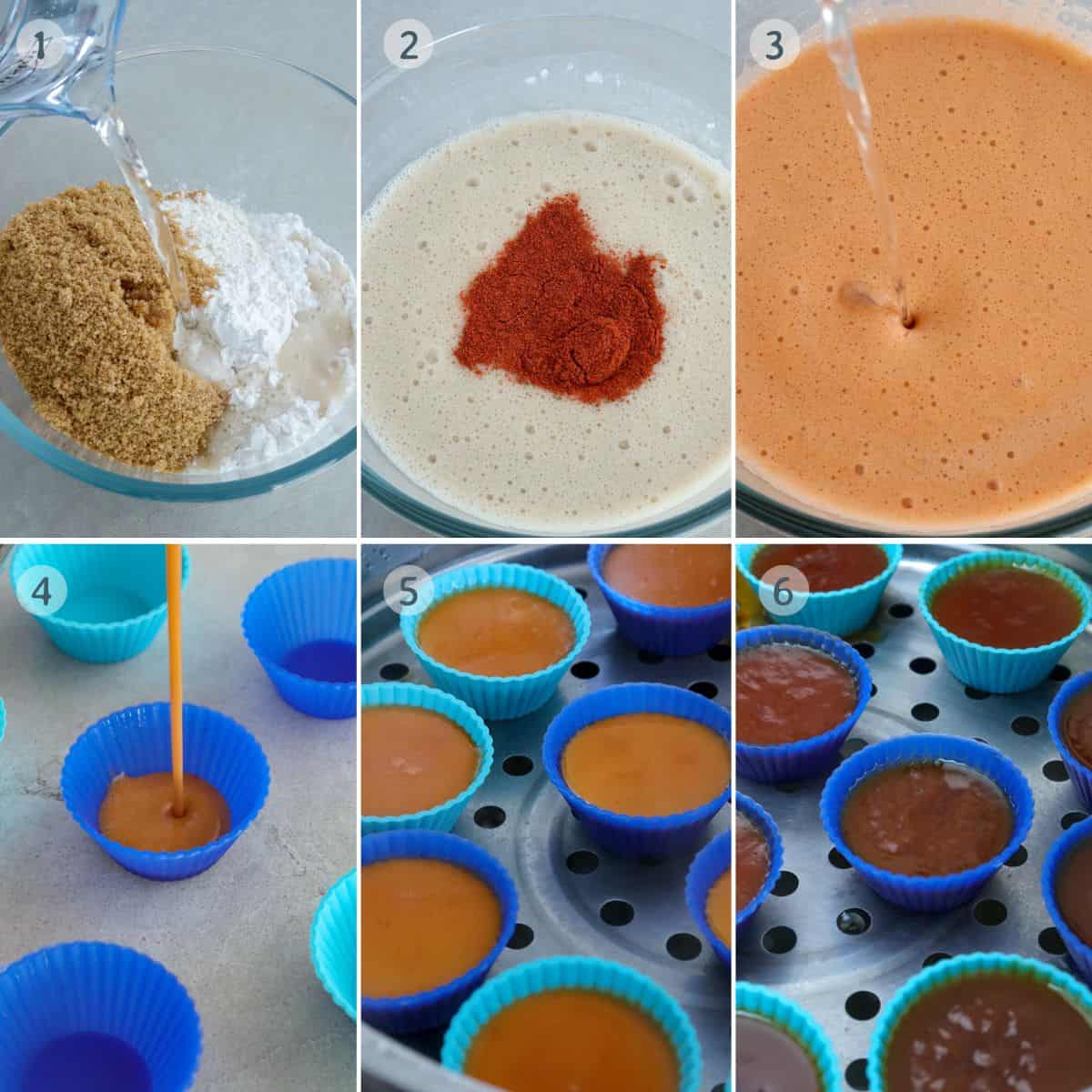
- Combine flour, tapioca flour, sugar, and water in a large bowl and stir well until dissolved and the mixture is smooth.
- Add atsuete and stir until well dispersed and the desired color is achieved.
- Add lye water and stir.
- Fill the silicone molds to about ¾ full. If using tin molds, lightly grease the insides with melted butter to make removing the steamed kutsinta easy.
- Fill the steamer with water and bring to a simmer. Arrange the filled molds in a single layer on the steamer basket and steam the kutsinta mixture until set.
- Remove from heat and allow to cool. Gently remove the steamed cakes from the molds and top with grated coconut.
Helpful tips
- Steam in a gentle simmer to prevent the kutsinta from sinking in the middle.
- These are mini-sized cuchinta; recipe yield depends on the size of molds you use.
- Stir the mixture before pouring it into the molds, as the flour tends to settle in the bottom.
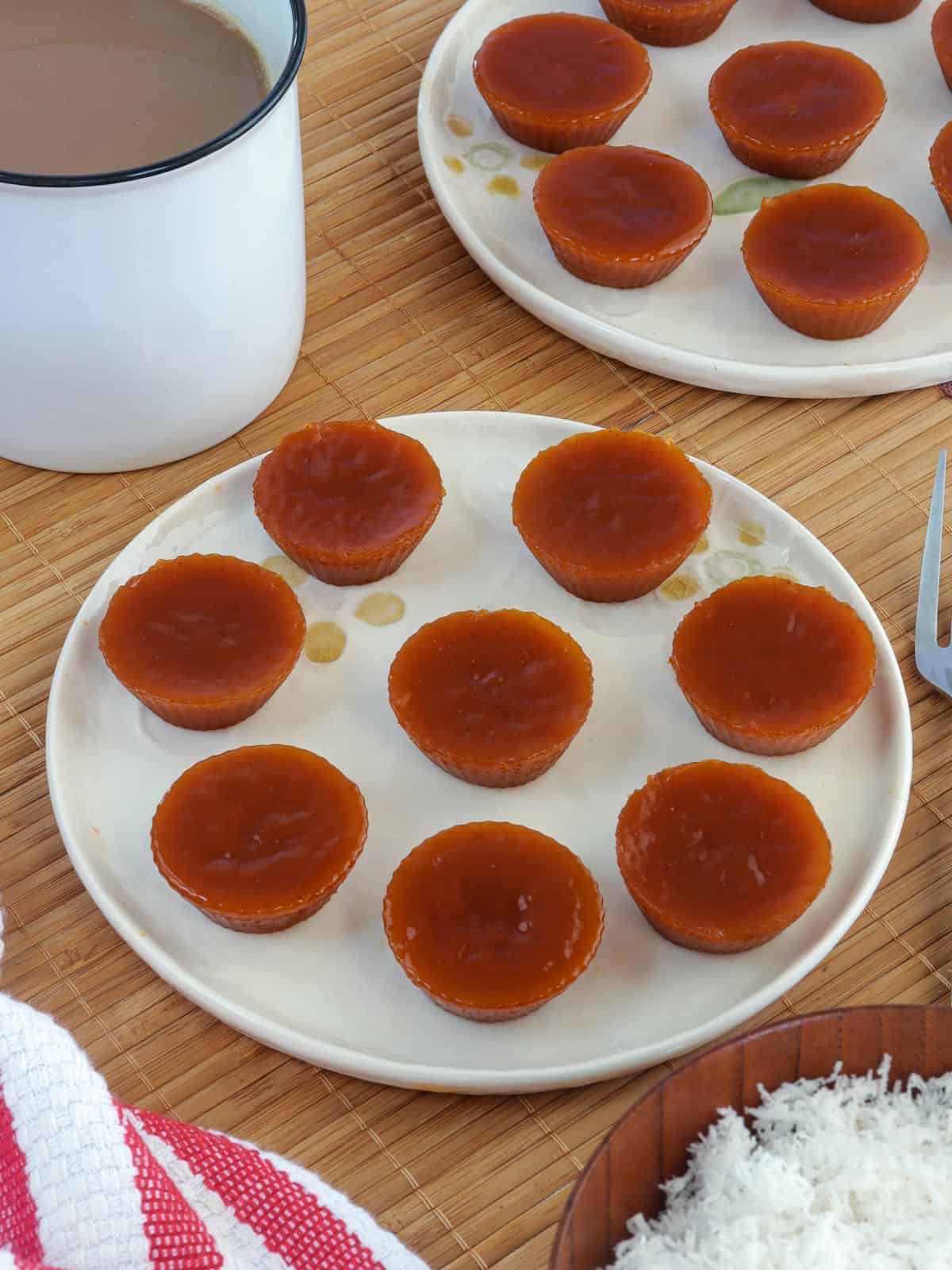
Flavor Variations
- Ube- use white sugar instead of brown sugar, skip the atsuete powder, and add a few drops of ube extract to the batter
- Black- use white sugar instead of brown sugar, skip the atsuete powder, and add a few drops of black food coloring to the batter
- Pandan- use white sugar instead of brown sugar, skip the atsuete powder, and add a few drops of pandan extract to the batter
Frequently Asked Questions
What lye water does in kutsinta?
Food-grade Lye water is a strong alkaline solution used in various cooking processes, such as curing and baking. It is a key ingredient in making kutsinta or pichi-pichi, as well as Chinese moon cakes, bagels, pretzels, and ramen noodles. It raises the pH level of the dough for a richer color and a springy texture.
If you prefer not to use lye or don't have access to it, you can read this article on using baked baking soda solution as an alternative.
How to serve and store
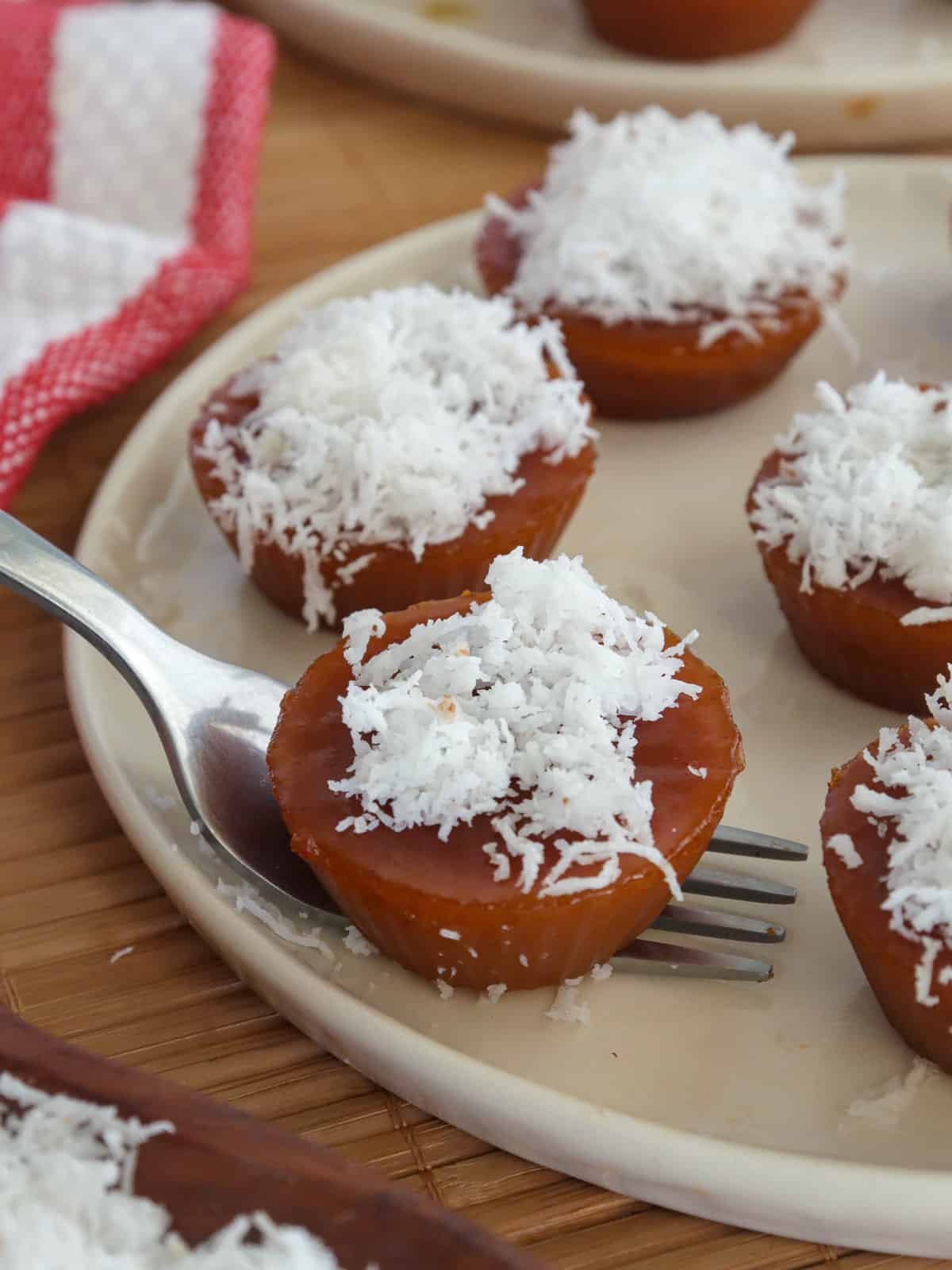
- Kutsinta are traditionally served for breakfast, midday snacks, or after-meal desserts. For a tasty treat, enjoy them with hot tsokolate or ice-cold calamansi juice!
- Top the steamed cakes with grated coconut (niyog) or toasted desiccated coconut (budbod). You can skip the coconut and dip them in dulce de leche or yema spread.
- To store, transfer to a container with a tight-fitting lid and refrigerate for up to 3 days. For longer life, top with coconut when ready to serve
More snack recipes
Ingredients
- 1 ½ cups flour
- ½ cup tapioca flour
- 1 ½ cups dark brown sugar
- 3 cups water
- 1 tablespoon atsuete powder
- 1 tablespoon lye water
Equipment
- silicone molds
- Steamer
Instructions
- In a bowl, combine flour, tapioca flour, sugar, and water. Stir well until dissolved and mixture is smooth.
- Add atsuete and stir until well dispersed and the desired color is achieved.
- Add lye water and stir.
- Fill molds to about ¾ full.
- Add water to the steamer and bring to simmer over medium heat.
- Steam kutsinta for about 40 to 45 minutes or until mixture is set. Remove from heat and allow to cool.
- Gently remove from molds and top with grated coconut.
Notes
- The atsuete is primarily added to deepen the color and you can use more or less depending on the brown sugar you use.
- If using tin molds, you might need to grease the insides to make removing the steamed cakes easy.
- Steam in a gentle simmer to prevent the kutsinta from sinking in the middle.
- These are mini-sized cuchinta; recipe yield depends on the size of molds you use.
- Stir the mixture between pouring into the molds as the flour settles in the bottom.
- Nutritional info is calculated at two pieces per serving.
Video

Nutrition Information
“This website provides approximate nutrition information for convenience and as a courtesy only. Nutrition data is gathered primarily from the USDA Food Composition Database, whenever available, or otherwise other online calculators.”

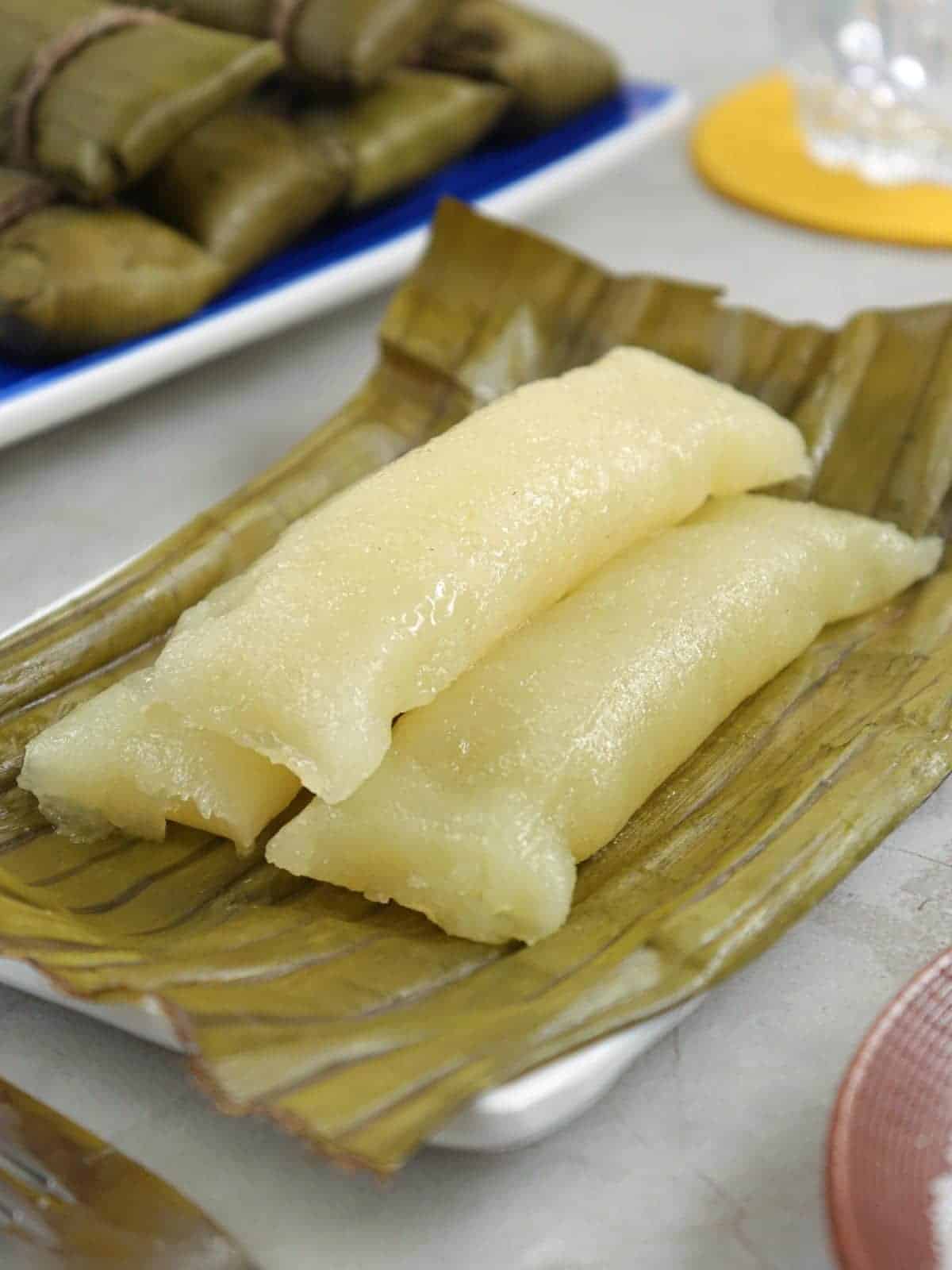
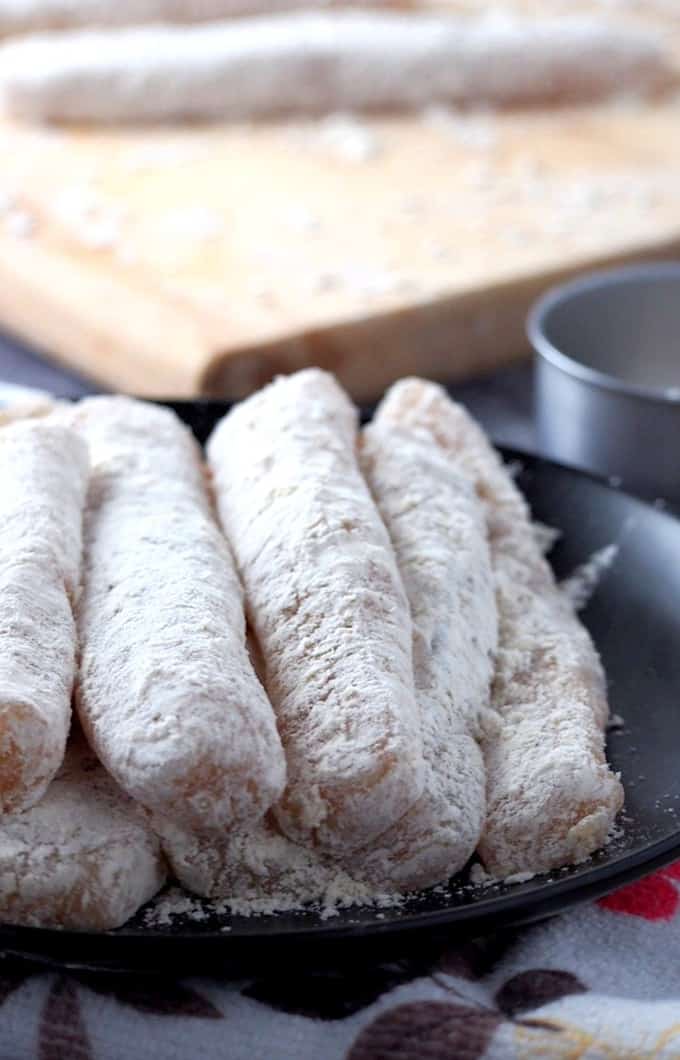
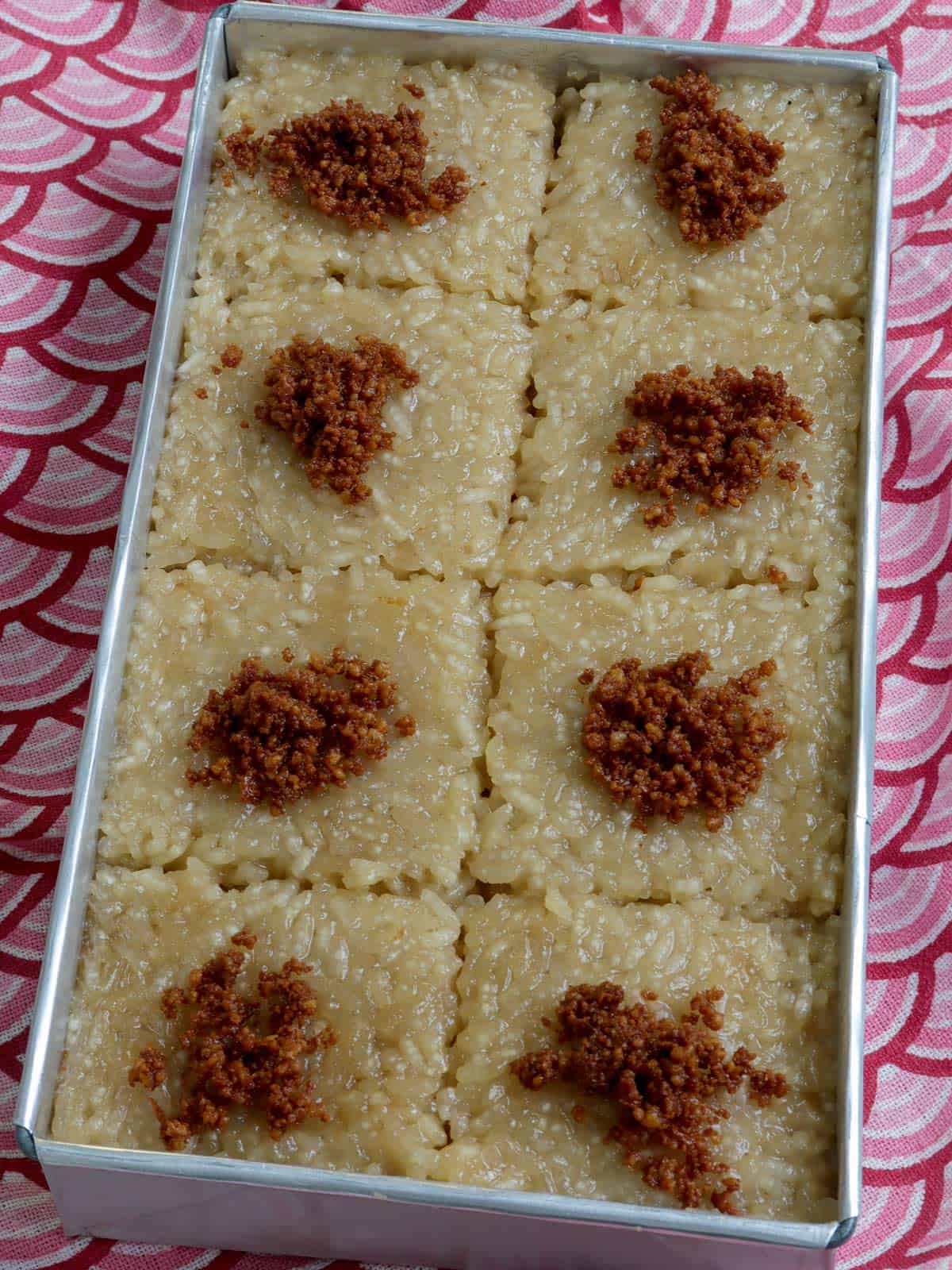
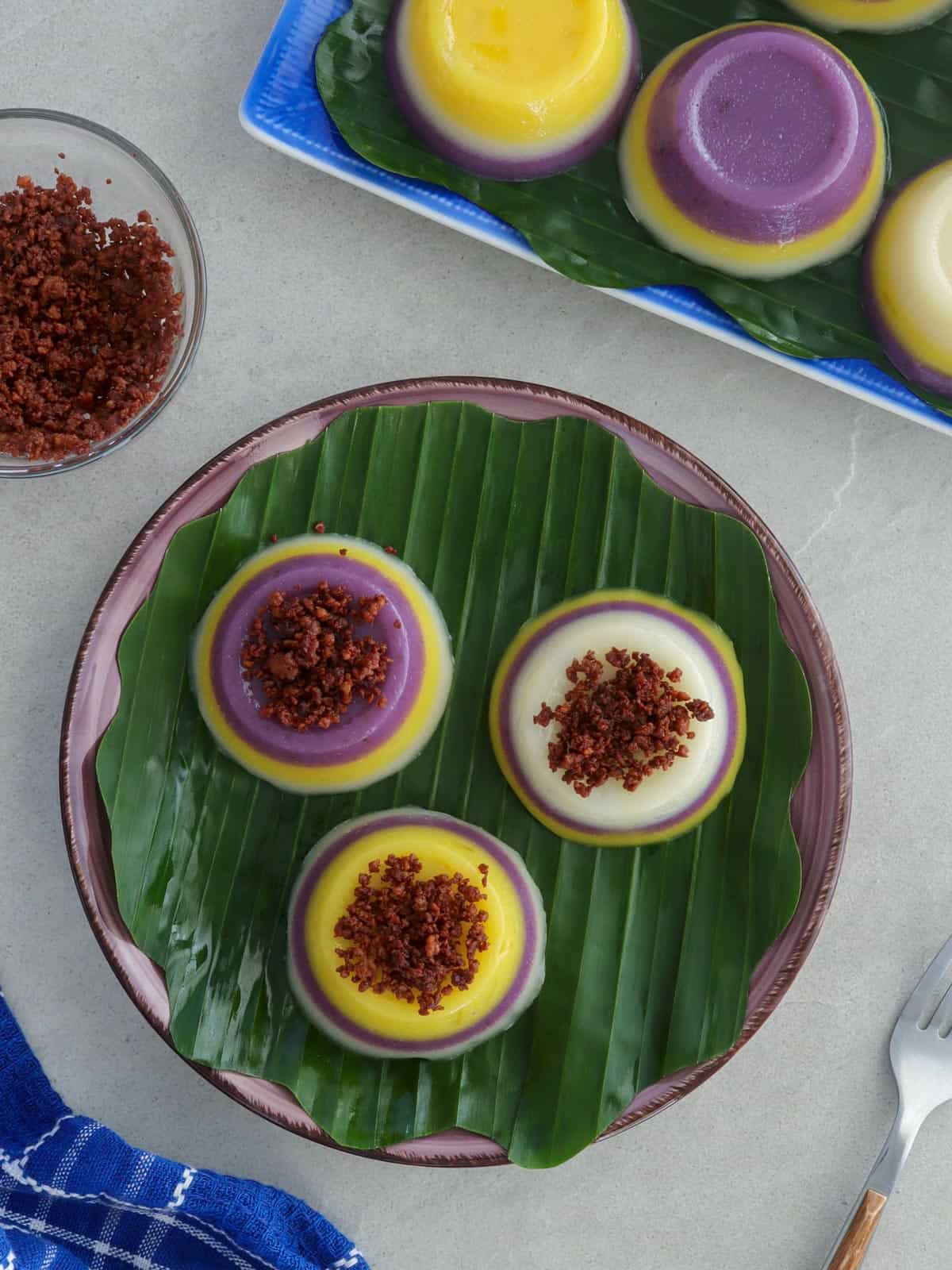
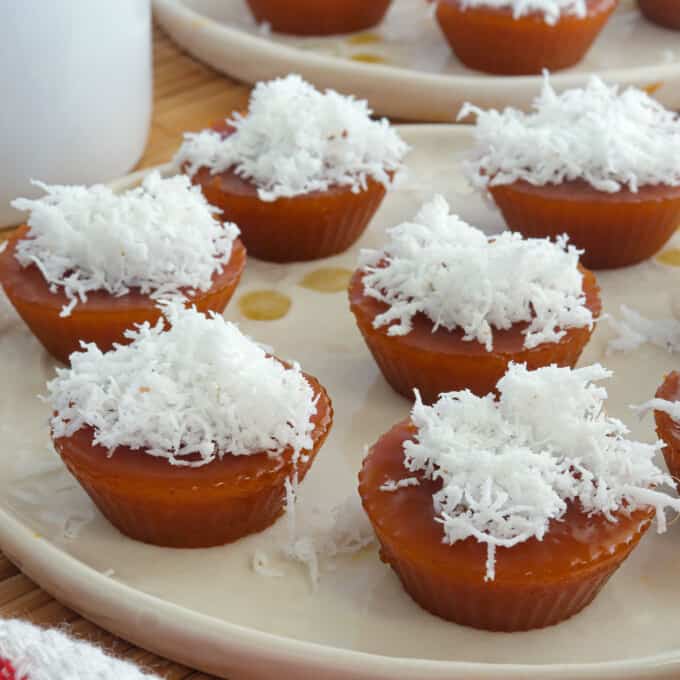
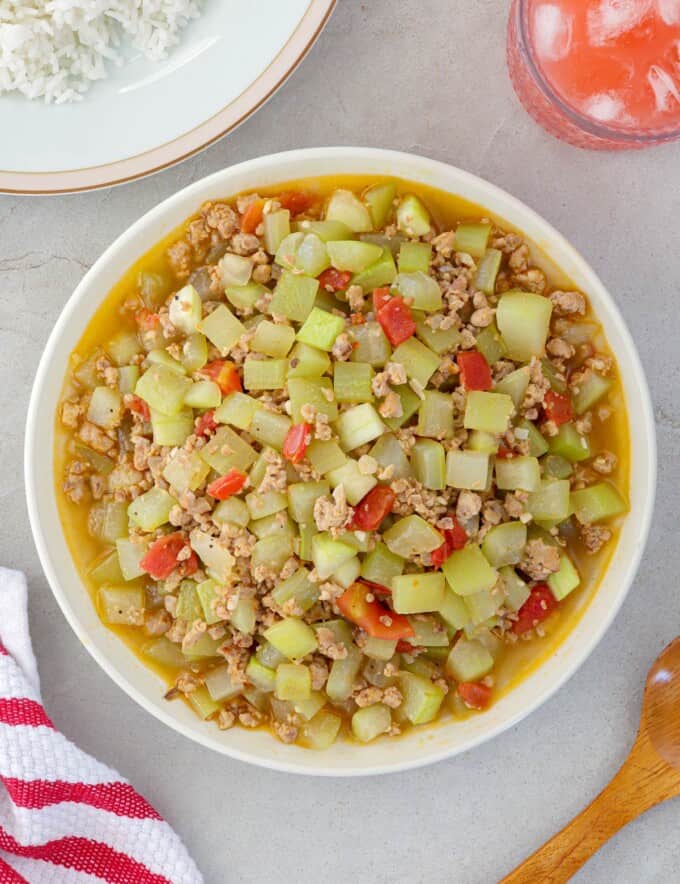
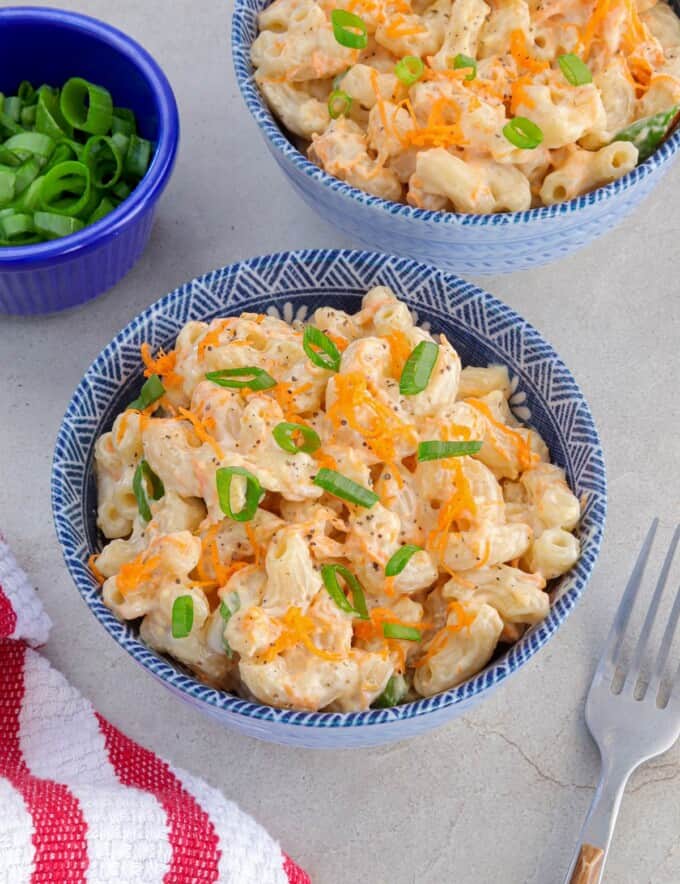
Mary reed says
Looks so good
Lalaine Manalo says
They are really good! *drool*
Eunice Ayuman says
Hi may I ask what is tapioca Flour is this different with glutinous rice flour?
Lalaine Manalo says
Tapioca flour is made of cassava root and yes, it's different from glutinous rice flour which is made of malagkit rice.
Ligaya Benedicto says
gumawa na ako ng kutsinta gamit ang ibang recipe pero hindi gusto mr. ko ako lng umubos. pero try ko yong recipe mo ate napa wow sa sarap mr ko. dami nya nakain pra daw cyang nakakain galing pinas. dinagdagan ko lng ng sugar, ska dinaya ko yong minutes ate ng pagluto. ginawa ko lng na 25 minutes. ano pagkakaiba ate pag nasteam sya ng 40 to 45minutes.
carolyn Degracia says
hello lalimainr is it possible to eliminate the asuete and add some food color instead? I wanted it black...
Lalaine Manalo says
Yes, you can omit the atsuete. It's mostly to add an orange hue to the kutsinta so if you're using black color, no need for it 🙂
Irish says
I am looking for a kutsinta recipe on google and there’s a lot of different kind of kutsinta recipes in the web. However as I am going thru reviews, your’s is one of the most positive comment in terms of the outcome. So today I made a kutsinta following your recipes with the correct ingridients as you have listed in your website. Its my first time to cook this kind of dessert and the outcome was unbelievable. Kudos to you. You are true with your recipes. Its chewy and its really delicious. Thank you for sharing it. Blessings
Lalaine Manalo says
Thank you so much for the feedback, Irish. I can't take full credit for the recipe because my kumare gave it to me 🙂 I am glad you enjoyed it!
Ramiel Deals says
Hi there! I just like to tell everyone that tapioca starch/flour is just a baker's term for cassava starch/flour. And so is sodium bicarbonate just another name for baking soda/powder.
Kristi says
Saan po makakahanap ng steamer na ganyan? Thank you po.
Kristi
Lalaine Manalo says
Nabili ko po online 🙂
Editha carter says
Hi ms lalaine, is the flour you used, is just plain flour?
Thanks
Lalaine Manalo says
Yes, I used plain flour and tapioca flour.
Nancy says
Hi. Do you know how long does the Kutsinta last?
I'm thinking to put them just on the counter for 2 days. Not in the fridge. Is that ok? Hope to hear from you soon! Thank you again for sharing the recipe.
Lalaine Manalo says
Without the coconut, I think it should be ok at room temperature for a day or two, but the best option is to refrigerate. It should last up to 3 days.
Nancy says
I made this for the first time yesterday. I followed all the ingredients except i lessen the brown sugar from 1 1/2 cup to 1 cup. And I am so glad it turned out perfect! I shared some to my friends and OMG they all love it and requested me to make some more! Lol. Thank you for sharing this recipe. Soft and chewy indeed! It's the best!
Lalaine Manalo says
Nancy, I'm glad it turned out perfect and that your friends loved it. It's my pleasure sharing recipes with everyone!
Anne says
Can I use tapioca starch instead of flour?
GEMMA A WISEMAN says
I just found out this recipe lately.I will try to make this . I was going to ask what is the substitution for lyle water. I found the answer by reading one of your recipe ratings. She use the baking powder.
Lalaine Manalo says
I am glad you found the answer you needed; there are definitely a lot of helpful tips on the comment section from other readers. Please let me know how it turns out with the baking powder!
Buena Oran says
Hi ,
I wonder if corn starch can be used instead of Tapioca Flour? Thanks
Lalaine says
I am sorry, I've never tried it with cornstarch and can't vouch for the results 🙁
Buena Oran says
Hello,
Can I use Cornstarch instead of Tapioca Flour? thanks
Elvira says
What do you add to make black kutsinta?
Lalaine Manalo says
I am sure but I don't how to make it. First time I've heard of it, sounds interesting 🙂
Trang says
What’s kind of flour ? Thank you!
Lalaine says
It's tapioca flour and all-purpose flour 🙂
Grace says
I wanna make this today but I don’t have our water. it necessary to put iye water? I can’t find it 😔 any substitution ?
Lalaine Manalo says
Lye water adds chewiness. Nasa post po yung link sa possible substitute 🙂
Regina salazar says
Can I use Cassava flour instead in place of tapioca flour?
Lalaine Manalo says
I researched online and this is what I read, "Both products are made from cassava root, but cassava flour incorporates the whole root, whereas tapioca flour is made up of only the starchy part of the plant. In most recipes, cassava flour can be swapped evenly for tapioca, but the fiber content gives it slightly more thickening power".
If using cassava flour, you might have to adjust the amount.
riva says
This is my first time following your recipe! Thank you, it's exactly how I like the taste to be! I just had to steam longer than 45 mins. I also used silicone molds but found it hard to remove so next time I'll grease the sides. Thanks again!